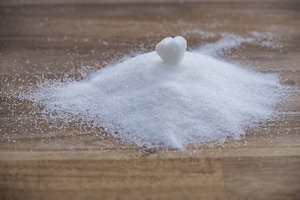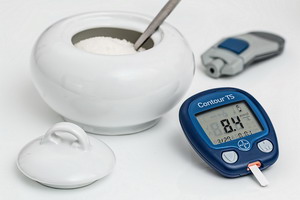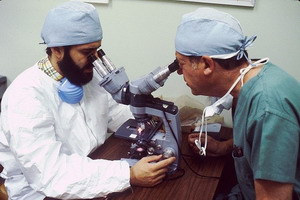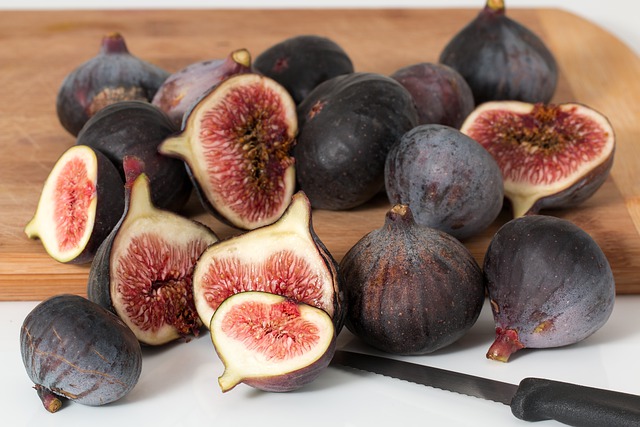 Almost everybody loves sugar, but there are many different kinds of sugar. The lovely white stuff we are all familiar with is called sucrose, which is actually two other sugars hooked together — glucose and fructose. When we eat table sugar in our cakes, cookies, and candy, it is almost immediately broken down into its two halves and absorbed through the gut wall, and picked up by the bloodstream. From here it is carried first to the liver, then into the general circulation.
Almost everybody loves sugar, but there are many different kinds of sugar. The lovely white stuff we are all familiar with is called sucrose, which is actually two other sugars hooked together — glucose and fructose. When we eat table sugar in our cakes, cookies, and candy, it is almost immediately broken down into its two halves and absorbed through the gut wall, and picked up by the bloodstream. From here it is carried first to the liver, then into the general circulation.
 We are familiar with glucose. It is what is called blood sugar. Glucose is what doctors measure to see if you are moving into diabetes. If you are healthy your blood sugar levels will be between 70 and 90 mg/dl. At least back when I was in school that was considered normal. These days they allow the upper level to go up to 99 before they frown at you. If you have heard of hemoglobin A1C as the test for diabetes, this is another way of measuring glucose by how much of the protein in your blood cells have become attached to glucose. The weird thing is the reason we like sugar is that it is sweet. Glucose is not particularly sweet. When nature hooks a bunch of glucose molecules together, it forms starches (carbs) and fibers — like bread, potatoes, and wood pulp. It is the fructose attached to the glucose in table sugar that carries most of the sweetness. Fructose is twice as sweet as glucose.
We are familiar with glucose. It is what is called blood sugar. Glucose is what doctors measure to see if you are moving into diabetes. If you are healthy your blood sugar levels will be between 70 and 90 mg/dl. At least back when I was in school that was considered normal. These days they allow the upper level to go up to 99 before they frown at you. If you have heard of hemoglobin A1C as the test for diabetes, this is another way of measuring glucose by how much of the protein in your blood cells have become attached to glucose. The weird thing is the reason we like sugar is that it is sweet. Glucose is not particularly sweet. When nature hooks a bunch of glucose molecules together, it forms starches (carbs) and fibers — like bread, potatoes, and wood pulp. It is the fructose attached to the glucose in table sugar that carries most of the sweetness. Fructose is twice as sweet as glucose.
 The high sweetness of fructose is why high fructose corn syrup was invented. Used in food and beverage manufacture, it takes less of this type of sugar syrup to sweeten a food or beverage, thereby saving costs. If you want some super sweet syrup, go for agave syrup. It will be up to 90% fructose. Back in the 70s, doctors thought fructose was a terrific sweetener because it does not raise your glucose blood sugar levels. Unfortunately, this view was very shortsighted. It turns out that it is the fructose that is the actual cause of the metabolic damage that turns into diabetes. High blood sugar is just an easily measurable byproduct of the damage. Glucose does eventually start causing its own secondary problems by binding to proteins in nerves and blood vessels.
The high sweetness of fructose is why high fructose corn syrup was invented. Used in food and beverage manufacture, it takes less of this type of sugar syrup to sweeten a food or beverage, thereby saving costs. If you want some super sweet syrup, go for agave syrup. It will be up to 90% fructose. Back in the 70s, doctors thought fructose was a terrific sweetener because it does not raise your glucose blood sugar levels. Unfortunately, this view was very shortsighted. It turns out that it is the fructose that is the actual cause of the metabolic damage that turns into diabetes. High blood sugar is just an easily measurable byproduct of the damage. Glucose does eventually start causing its own secondary problems by binding to proteins in nerves and blood vessels.
 The information I am about to write about is not yet taught to doctors. It takes about 20 years for discoveries in the world of physiology research to be replicated and more deeply researched before a general consensus by leading researchers across the world takes place. Only then is the information picked up by the medical schools and taught. It might be another 10 years before new knowledge is accepted by the general medical community. The exception to this is in the world of drug development. The drug companies employ physician educators called drug reps to go out and teach the doctors in the field new information about research that supports the use of the newest drugs. Otherwise, there is a 30-year time lag for the adoption of new knowledge.
The information I am about to write about is not yet taught to doctors. It takes about 20 years for discoveries in the world of physiology research to be replicated and more deeply researched before a general consensus by leading researchers across the world takes place. Only then is the information picked up by the medical schools and taught. It might be another 10 years before new knowledge is accepted by the general medical community. The exception to this is in the world of drug development. The drug companies employ physician educators called drug reps to go out and teach the doctors in the field new information about research that supports the use of the newest drugs. Otherwise, there is a 30-year time lag for the adoption of new knowledge.
 I did a PubMed search on the subject of fructose and metabolic syndrome and it listed over 22 thousand articles. This is a very well-researched subject. And yet hardly anyone in the medical community is aware of this research. It is almost like we don’t want to know that things that taste sweet are killing us. There might even be influence by a couple of people who profit from the selling of sweet products (or possibly the selling of diabetes medications) keeping this information under wraps. I was alerted to the dangers of fructose about 10 years ago by listening to a lecturer from UCSF, Dr. Robert Lustig MD. He has set up an informational website called sugarscience.ucsf.edu. More recently I listened to a long interview/lecture of kidney specialist Dr. Rick Johnson by Peter Attia MD covering the biochemistry and lab studies establishing the pathways triggered by fructose that cause all the damage to the body.
I did a PubMed search on the subject of fructose and metabolic syndrome and it listed over 22 thousand articles. This is a very well-researched subject. And yet hardly anyone in the medical community is aware of this research. It is almost like we don’t want to know that things that taste sweet are killing us. There might even be influence by a couple of people who profit from the selling of sweet products (or possibly the selling of diabetes medications) keeping this information under wraps. I was alerted to the dangers of fructose about 10 years ago by listening to a lecturer from UCSF, Dr. Robert Lustig MD. He has set up an informational website called sugarscience.ucsf.edu. More recently I listened to a long interview/lecture of kidney specialist Dr. Rick Johnson by Peter Attia MD covering the biochemistry and lab studies establishing the pathways triggered by fructose that cause all the damage to the body.
 Let’s dive into the fructose story just a bit. The cells use glucose and fructose to make chemical energy called ATP. ATP is the gas that fuels almost everything that happens in the body. The first step in this process actually uses up some ATP to start the breakdown of glucose and fructose. The big difference between the two is the glucose breakdown is carefully regulated to not use up too much ATP while the fructose breakdown is not regulated and will run wild and use up all the ATP energy in the cell if there is too much fructose to process. In this wild process, the used-up ATP gets converted into uric acid. This is bad. Uric acid is inflammatory and damages our energy factories (the mitochondria) and acts as a signal that tells our body to make and store fat. Not only that, but this pathway also triggers hormonal changes that make us always feel hungry and it slows down our metabolism. So there you have it. Fructose (in excess) inflames us, makes us fat, and always hungry. Even worse, the more this happens, the more it is set up to happen in the future.
Let’s dive into the fructose story just a bit. The cells use glucose and fructose to make chemical energy called ATP. ATP is the gas that fuels almost everything that happens in the body. The first step in this process actually uses up some ATP to start the breakdown of glucose and fructose. The big difference between the two is the glucose breakdown is carefully regulated to not use up too much ATP while the fructose breakdown is not regulated and will run wild and use up all the ATP energy in the cell if there is too much fructose to process. In this wild process, the used-up ATP gets converted into uric acid. This is bad. Uric acid is inflammatory and damages our energy factories (the mitochondria) and acts as a signal that tells our body to make and store fat. Not only that, but this pathway also triggers hormonal changes that make us always feel hungry and it slows down our metabolism. So there you have it. Fructose (in excess) inflames us, makes us fat, and always hungry. Even worse, the more this happens, the more it is set up to happen in the future.
 One extra piece to this puzzle. Our bodies can convert glucose into fructose. Certain cells prefer fructose for energy. But normally only a small amount of glucose is converted this way. But when we eat a lot of carbs regularly, so we have an abundance of blood sugar, a special pathway called the polyol pathway, converts up to one-third of our glucose into fructose. This conversion happens not only when there are high amounts of blood sugar, but high amounts of anything that increases the thickness of the blood, including salt. Yes, too much salt in the diet will trigger the conversion of glucose into fructose. This glucose to fructose mechanism is believed to cause many health problems associated with diabetes. So we don’t even have to eat sugar to develop the sugar damage caused by fructose. Our body will make its own inflammatory fructose! This is crazy, or is it?
One extra piece to this puzzle. Our bodies can convert glucose into fructose. Certain cells prefer fructose for energy. But normally only a small amount of glucose is converted this way. But when we eat a lot of carbs regularly, so we have an abundance of blood sugar, a special pathway called the polyol pathway, converts up to one-third of our glucose into fructose. This conversion happens not only when there are high amounts of blood sugar, but high amounts of anything that increases the thickness of the blood, including salt. Yes, too much salt in the diet will trigger the conversion of glucose into fructose. This glucose to fructose mechanism is believed to cause many health problems associated with diabetes. So we don’t even have to eat sugar to develop the sugar damage caused by fructose. Our body will make its own inflammatory fructose! This is crazy, or is it?
 Many studies of animals that hibernate in the winter demonstrate that this inflammatory weight-promoting type of metabolism is a necessary survival process. In nature, the only time of the year when there is an abundance of fructose is from fruit and starchy vegetables in the autumn. By eating fruit and starchy vegetables, animals (and us) are triggered into excess hunger and the storing of lots of fat to provide them enough energy to survive a winter without much to eat. The inflammation for a month or two is an excellent trade to promote weight gain for the winter. The starvation in the winter triggers autophagy to eat up the damaged cells and replace them with new ones, so no long-term harm is done.
Many studies of animals that hibernate in the winter demonstrate that this inflammatory weight-promoting type of metabolism is a necessary survival process. In nature, the only time of the year when there is an abundance of fructose is from fruit and starchy vegetables in the autumn. By eating fruit and starchy vegetables, animals (and us) are triggered into excess hunger and the storing of lots of fat to provide them enough energy to survive a winter without much to eat. The inflammation for a month or two is an excellent trade to promote weight gain for the winter. The starvation in the winter triggers autophagy to eat up the damaged cells and replace them with new ones, so no long-term harm is done.
 That works great if the only time during the year you eat sugar or lots of carbs is the harvest season — late summer/autumn. The damage is repaired through the agency of starvation in the winter. How well do we adhere to this pattern of eating and starvation? We don’t! That is why 80% of the population is overweight and inflamed, also called metabolic syndrome. Almost 50% of the population is now considered obese. Rates of diabetes are skyrocketing. Chronic over-consumption of carbs and sugars is the culprit. This is a slow process, and as I explained it is a natural process at the right time and place. Sugar is useful when we want to gain weight in preparation for a period of food scarcity. But when we use it all the time or overeat carbs for a long time, the fat storage process becomes automatic and self-perpetuating.
That works great if the only time during the year you eat sugar or lots of carbs is the harvest season — late summer/autumn. The damage is repaired through the agency of starvation in the winter. How well do we adhere to this pattern of eating and starvation? We don’t! That is why 80% of the population is overweight and inflamed, also called metabolic syndrome. Almost 50% of the population is now considered obese. Rates of diabetes are skyrocketing. Chronic over-consumption of carbs and sugars is the culprit. This is a slow process, and as I explained it is a natural process at the right time and place. Sugar is useful when we want to gain weight in preparation for a period of food scarcity. But when we use it all the time or overeat carbs for a long time, the fat storage process becomes automatic and self-perpetuating.
 This has been a lot of physiologic details to explain why it can be so difficult to lose weight and reduce inflammation in all its many forms. Our food abundance has screwed up our normal metabolism. We have been living so long this way that our body has learned to keep us gaining weight even when we are being really good on our diet. I did pick up one hopeful possibility. Several drugs have been developed to block the enzymes that convert glucose to fructose. This is the pathway that keeps the problems going even when we get completely off the sugar. These are called aldose reductase inhibitors. In researching these drugs, I found one natural substance that does the same thing — berberine. I don’t have any research looking at berberine for this purpose in humans, but I already use berberine for blood sugar management. Berberine at 500mg three times a day has shown similar effects to the popular blood sugar drug Metformin. I could probably do a whole newsletter just on berberine.
This has been a lot of physiologic details to explain why it can be so difficult to lose weight and reduce inflammation in all its many forms. Our food abundance has screwed up our normal metabolism. We have been living so long this way that our body has learned to keep us gaining weight even when we are being really good on our diet. I did pick up one hopeful possibility. Several drugs have been developed to block the enzymes that convert glucose to fructose. This is the pathway that keeps the problems going even when we get completely off the sugar. These are called aldose reductase inhibitors. In researching these drugs, I found one natural substance that does the same thing — berberine. I don’t have any research looking at berberine for this purpose in humans, but I already use berberine for blood sugar management. Berberine at 500mg three times a day has shown similar effects to the popular blood sugar drug Metformin. I could probably do a whole newsletter just on berberine.
 So this newsletter is heavy with physiology that basically says sugar = bad, excess carbs = bad, and excess food = bad. The sneaky thing is this badness is slow to build up, so we don’t notice it while it is happening until it is too late. A few folks that simply don’t eat enough calories each day to trigger this “abundance equals weight gain” pathway will point to their diet choices as righteous and good. To the extent that those choices cause them to eat foods with a low caloric density, they are probably right. But such diets are usually deficient in many necessary nutrients so they simply develop different diseases than the rest of us.
So this newsletter is heavy with physiology that basically says sugar = bad, excess carbs = bad, and excess food = bad. The sneaky thing is this badness is slow to build up, so we don’t notice it while it is happening until it is too late. A few folks that simply don’t eat enough calories each day to trigger this “abundance equals weight gain” pathway will point to their diet choices as righteous and good. To the extent that those choices cause them to eat foods with a low caloric density, they are probably right. But such diets are usually deficient in many necessary nutrients so they simply develop different diseases than the rest of us.
 Probably the best diet advice comes from the “eat seasonally” folks. When you eat only foods that are available naturally in your local area that are in season and in the amounts that would be available in a natural hunter-gatherer lifestyle, you most closely mimic the health patterns built into your body. The really tough one for folks is getting used to not eating when food is supposed to be scarce. We don’t like going hungry, even when it is good for us. There is no one best answer for this health crisis we are facing, but identifying the big obvious enemies can help us make better choices.
Probably the best diet advice comes from the “eat seasonally” folks. When you eat only foods that are available naturally in your local area that are in season and in the amounts that would be available in a natural hunter-gatherer lifestyle, you most closely mimic the health patterns built into your body. The really tough one for folks is getting used to not eating when food is supposed to be scarce. We don’t like going hungry, even when it is good for us. There is no one best answer for this health crisis we are facing, but identifying the big obvious enemies can help us make better choices.
Take care,
David
